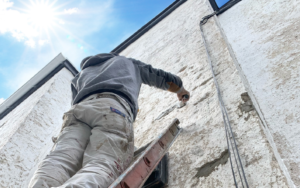Stucco is a beautiful and durable material, but it can develop problems over time. If these problems are not addressed early, they can lead to costly replacements. Click here to Learn More Here.
The first step is to assess the damage to your stucco. Look for cracks, holes, discoloration, and efflorescence (white powdery residue caused by soluble salts migrating to the surface of the stucco). The type and extent of the damage will determine your repair strategy.

Stucco Repair is a valuable service for homeowners that can help to maintain the integrity of their homes and add to their overall value. However, there are a number of factors that can increase the cost of stucco repairs, including the size and complexity of the home, and the location and condition of the damaged areas.
The first step of any stucco repair project is to inspect the area and determine the cause of the damage. This will allow the contractor to create a plan and give you an estimate of the total cost of the project. Once the plan is in place, the actual repair process can begin.
Some of the most common problems with stucco are small cracks, mold, and water damage. Most of these issues are caused by environmental factors or installation errors. While some of these issues can be fixed with simple crack filling, some require more extensive work and remediation. The type of stucco also plays a role in the cost. For example, if you have EIFS stucco that is backed with insulation, it can experience severe problems like moisture intrusion, which requires a more extensive repair than regular cement-based stucco.
Other costs associated with stucco repair include the cost of materials and any required labor. Depending on the extent of the damage, this can range from a few dollars per linear foot to more than $50 per square foot. This includes the cost of the stucco, sand, cement backerboard, and any necessary finishing materials.
The cost of labor can also vary based on the size of the home and the location of the damaged areas. For example, if the damaged stucco is located on a second or third story of a home, the contractor will need ladders or scaffolding to access the area, which can significantly increase the cost of the project.
Another factor to consider is whether the repairs are for the whole house or just a few areas. If you are just fixing a few cracks, the cost will be significantly less than if you’re fixing an entire facade. This is because the material and labor costs will be higher for larger projects.
Time
Stucco is a beautiful, durable material that can enhance the exterior of your home. However, like any other building material, stucco can develop cracks and holes over time. If left untreated, these issues can escalate, leading to moisture intrusion and more expensive repairs down the line. To avoid further damage, it is essential to repair these problems as soon as possible.
The first step in repairing stucco is to identify the problem areas. You can start by looking for cracks and gaps around windows, doors, and roof connections. You may also want to inspect your gutters and downspouts to ensure that they are directing rainwater away from the walls. It is also a good idea to apply a waterproofing product.
Next, you will need to clean the damaged area. You can use a wire brush to remove any debris and dirt. This will help ensure proper adhesion for the new stucco. Once the surface is clean, you can begin to repair the cracks. There are several different repair methods, but the most common is to use a caulk gun and a stucco mix. You can purchase a pre-mixed version of this mixture, or you can use a dry mix that requires water to be added. Either way, it is important to select a repair mixture that matches your existing stucco texture.
Once the caulk is applied, it needs to dry for a few days. During this process, you can protect the area with a tarp to prevent sun and rain from damaging the new stucco. It is also a good idea to mist the repaired area occasionally during the drying process. This can help slow the drying process and improve the quality of the repair.
Once the caulk has dried, it is ready to be painted. It is a good idea to consult with a professional before choosing a paint color, as stucco can be difficult to match. In addition, a professional can determine why the stucco cracked in order to prevent future issues. This could include reinforcing the wall, adding expansion joints, or installing a weep screed.
Materials
Stucco is a popular home-building material that can be used for walls, columns, or other surfaces. It is made from fine aggregates and a cementitious binder that creates a mortar-like finish. It is often used for the exterior of buildings and houses due to its durability, longevity, and aesthetic appeal.
Like any other material, stucco can deteriorate over time and need to be repaired or replaced. Moisture intrusion, improper installation, and other issues can lead to cracking, discoloration, or even mold growth. It is important to address the problem as soon as possible to prevent further damage and costly repairs in the future.
There are several different materials needed to repair stucco. Depending on the type of damage, the proper material must be chosen. For instance, if the issue is moisture-related, a weep screed may be required. A weep screed is a pice of metal that allows any moisture in the wall to weep out instead of building up and damaging the stucco.
If the issue is caused by impact or normal stresses, a simple joint compound should work. However, if the damage is more severe or has occurred in the same area on multiple occasions, it might be best to replace the stucco altogether.
Once the proper materials have been selected, it is time to start the repair process. A good place to begin is by cleaning the damaged areas. A scrub brush or pressure washer should be used, and the area should be hosed down with clean water to ensure that any debris is removed.
It is then important to determine the depth of the damage. A visual inspection is usually sufficient, but a moisture meter may also be useful to help identify any problems with the lath or other components of the structure. It is also crucial to replace any rotted wood, as this will not provide the necessary support for new stucco.
Once the repairs have been completed, it is a good idea to seal them to prevent moisture intrusion in the future. This can be done with a stucco sealer, which is available at most hardware or home improvement stores. Follow the manufacturer’s instructions carefully, as it is important to use the right product for the job.
Expertise
The first step in the stucco repair process is a visual inspection. It’s important to determine if the damage is surface level or is the result of larger, underlying problems. This is particularly important for structural issues like mold and water damage. Moisture damage is a major cause of deterioration, and the underlying problem needs to be addressed before stucco can be repaired or replaced.
Moisture damage can be identified by a variety of methods, such as a moisture meter or by inspecting the depth of the damage. If the damage extends past the brown coat and into the lath (the mesh framework that the stucco is applied to), a full remediation is needed. A full remediation is more expensive than a simple patch job, but it is necessary to prevent future damage and ensure that the stucco will last.
Skilled contractors have the experience to accurately assess stucco and provide an estimate for repair. They know the correct materials and techniques to use, ensuring that the repairs are durable and long-lasting. They also follow local building codes and regulations, ensuring that the work meets standards and passes inspections.
Stucco repairs should be done by a qualified contractor to minimize the risk of mold and other structural problems. In addition, experienced contractors will know how to correctly repair cracks and gaps that allow for moisture infiltration. They will also use waterproofing agents to prevent future infiltration.
Cracks are the most common indication that a stucco repair is needed. They can be hairline or spider-shaped, and they can occur for a variety of reasons. Some of the most common causes of cracks include weather conditions on the day that the stucco was installed, or a flaw in the mix that was used. If the cracks are caused by a structural issue, then they will need to be fixed with a reapplication of the stucco.
Other indications that a stucco repair is needed include a musty or moldy smell, or discoloration. Stucco repairs are typically more expensive than simple patchwork, but they are necessary to prevent further deterioration and mold growth.

